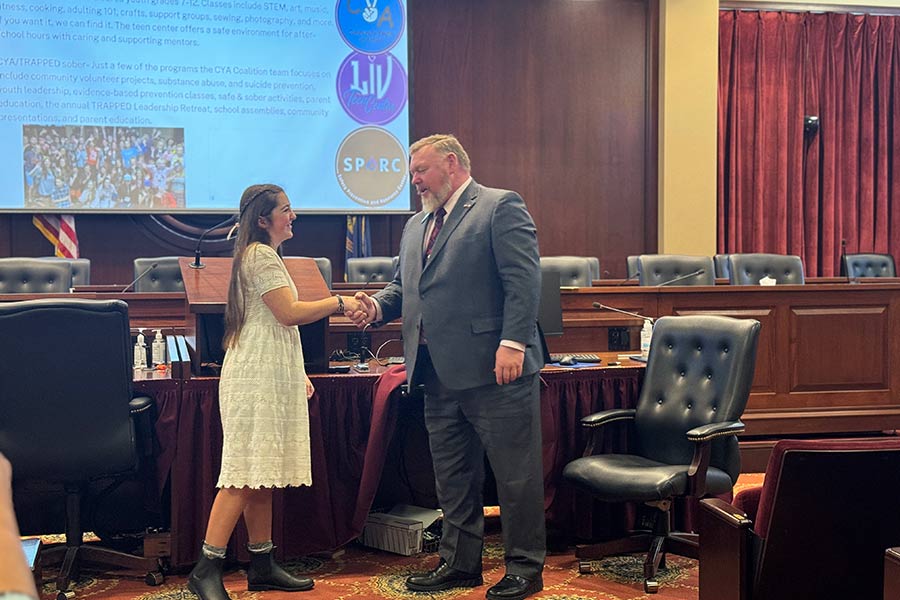
BOISE — A Southeast Idaho high school student who has been raising awareness of the dangers of fentanyl in her community brought her message to the state capitol.
Olive Ashcraft, a junior at Century High School, gave a presentation on February 19 to state legislatures about the importance of peers educating each other on the dangers of fentanyl abuse. Ashcraft has spent the last year working with her fellow student government officials to raise awareness of this epidemic.
“They’re trying to make these laws and these rules for kids like me. We’re the people that it really affects mostly, so I find it really important that they’re getting all the views and all the different perspectives from all different types of people, especially people my age that are living in this reality,” Ashcraft said.
While at the Idaho Capitol Building, Ashcraft got the opportunity to meet with Governor Brad Little, deliver a summary of her presentation and take a picture with him.
Ashcraft was invited to Boise by Representative Nate Roberts of District 29 after he saw an article about her work on EastIdahoNews.com. With the legislature debating two bills relating to fentanyl, one establishing mandatory minimum sentences for fentanyl trafficking and another to legalize fentanyl testing strips, Roberts thought it was a good idea to have her talk about the work she’s done to educate her community.
RELATED | Century High junior raises awareness to dangers of fentanyl in the community
“I was amazed that young people were taking that step and felt so engaged to do that,” Roberts said. “I was so proud of students in Pocatello and especially Olive for what they’re doing.”
Ashcraft delivered her presentation at the Lincoln Auditorium, which consisted of the information she and her peers presented to middle schoolers.
In their presentation, Ashcraft and her peers used visual aids to help kids understand how dangerous fentanyl is. At one point, she showed a picture of 2 mg of fentanyl balanced on the tip of a pencil, which is enough to kill a user.
“They were all shocked to see how such little amounts could kill,” Ashcraft said.
At another point in the presentation, Ashcraft would have middle schoolers eat a Fruit by the Foot without using their hands as fast as they could. Most of the time, the kids would finish between 17 and 25 seconds.
“And we kind of put that in perspective for them by telling them that’s how long it takes for someone to overdose on fentanyl, about 20 seconds,” Ashcraft said.
RELATED | Fentanyl testing strips are illegal in Idaho, but House Bill 441 seeks to change that
One of the points Ashcraft wanted to get across was that there should be a program in place so that kids can keep getting this information after she graduates next year. She said that she received positive feedback from the representatives and board members and was told it would benefit middle schoolers to continue receiving this presentation.
“They really liked the idea of a peer teaching a peer. That was what made them the most excited about the program,” Ashcraft said. “Kids are more likely to listen to other kids, rather than an adult.”
Roberts thought Ashcraft did “extremely well” with her presentation.
Roberts voted in favor of the bill to establish mandatory minimum sentences for fentanyl trafficking, and Ashcraft thinks it would work; however, they both believe that more education is the better solution.
RELATED | Will Idaho’s push for mandatory minimum criminal sentences for fentanyl be a deterrent?
Roberts also wants to see this education continue after Ashcraft graduates. He said that he hopes to find some way to use education or health funding to expand what she started.
Little offered advice to connect with the Office of Drug Policy
“I’m reaching out to that office to see if there’s something that we can get from them to help lock a program in where we can encourage fellow students, especially student leaders like Olive… find ways to continue this program and to continue to share the dangers with youth,” Roberts said.
Ashcraft hopes other young people will take her place after she leaves high school and continue spreading this message.
“I really don’t want this to fade once I graduate,” Ashcraft said.
